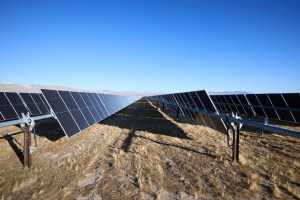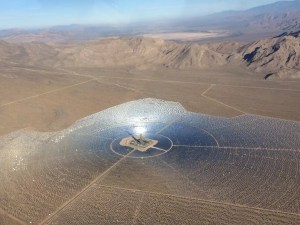By Kennedy Maize
Solar, solar everywhere
From the sun did drink;
Solar, solar somewhere
The sun did not sink.
Once upon a time, not that long ago, advocates of using sunlight to make electricity were in two camps. One group advocated using the energy from the sun to make heat, boil water, and use the steam to turn a turbine generator. The other approach, called “photovoltaics,” widely shortened to PV, called for using the physics of special flat panels to turn sunlight directly into electricity.
The solar thermal crowd initially held an edge with “concentrated solar power” (CSP) technology. In the late 1980s and 1990s, solar thermal was advancing while photovoltaics were lagging. As the New York Times reported in 1989, PV installations were far too expensive, compared to conventional ways of making electricity, while the solar thermal technology was most promising. Then Times energy reporter Matt Wald wrote, “But a more prosaic and less costly method of harnessing the sun, using mirrors to gather energy, is being expanded in the California desert northeast of Los Angeles.”
Wald’s insight proved blinkered. PV technology now rules the solar power roost and thermal projects have stalled and are fading. The Luz International project that Wald hyped soon collapsed. But other CSP projects were in the works, including the giant Ivanpah project near the California, Nevada desert border.
Sammy Roth, LA Times
Last week (Dec. 31) the Associated Press reported, “What was once the world’s largest solar power plant of its type appears headed for closure just 11 years after opening, under pressure from cheaper green energy sources. Meanwhile, environmentalists continue to blame the Mojave Desert plant for killing thousands of birds and tortoises.”
The reference is to the Ivanpah solar concentrating plant, which went into service in 2014 generating 386 MW with three units of mirrors and power towers spread across some five square miles of federal land. It sold power to Pacific Gas & Electric and Southern California Edison. The plant was financed by the Department of Energy to the tune of $1.6 billion.
As owner NRG said in a news release, “On January 14, 2025, Ivanpah’s owners and the DOE finalized negotiations with PG&E to terminate their two long-term purchase power agreements, allowing the DOE to maximize the recovery of its loans and provide savings for California ratepayers. Unit 2, contracted to SCE, is not covered under this agreement.” SCE is likely to abandon the third tower when its power purchase agreement expires.
NRG added, “Ivanpah proved to be a successful demonstration of CSP technology, however it has been surpassed by solar photovoltaics (PV) due to much lower capital and operating costs in producing clean energy.”
The Los Angeles Times headline on the column by climate writer Sammy Roth about the end of Ivanpah: “Farwell to Ivanpah, the world’s ugliest solar plant.”
As the Ivanpah project was cratering, Phoenix-based Arevon Energy on Dec. 9 announced the startup of its large solar PV project, Eland 1 Solar-plus-Storage Project in Kern County, Calif., with a second phase scheduled for operations this quarter. Eland 1 consists of 384-MW of PV generation and 150-MW/600 MWh of battery storage. The Eland 2 second phase is a duplicate; the final project will consist of 768-MW of generating capacity and 300 MW/1,200 MWh of storage.

Eland 1 and 2 have been financed with $2 billion of Biden administration’s Inflation Reduction Act money, administered through the Department of Energy. Eland 1 has a long-term power purchase agreement with the Southern California Public Power Authority for two of its members: Los Angeles Department of Water and Power and Glendale Water and Power.
Yesterday (Dec. 4), the Solar Energy Industries Association, the Washington solar lobbying group, announced that the U.S. has now surpassed 50 GW of solar PV module production capacity. The group says, “At full capacity, these factories can produce enough to meet all demand for solar in the United States.” In 2020, SEIA announced a goal of 50 GW of U.S. solar manufacturing capacity by 2030.
According to SEIA’s Solar and Storage Supply Chain Dashboard, companies “have announced plans for 56 GW of new U.S. solar cell production, as well as 24 GW of wafers and 13 GW of ingots. Solar tracker manufacturing capacity now exceeds 80 GW.”
SEIA president and CEO Abigail Ross Hopper said, “The U.S. is now the third largest module producer in the world because of these policy actions. This milestone not only marks progress for the solar industry but reinforces the essential role energy policies play in building up the domestic manufacturing industry that American workers and their families rely on.”
For back issues and a searchable archive, The Quad Report.












